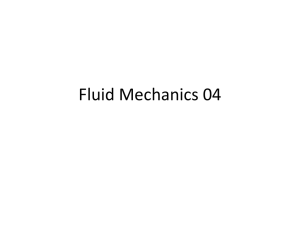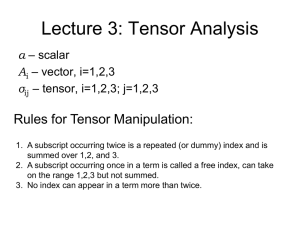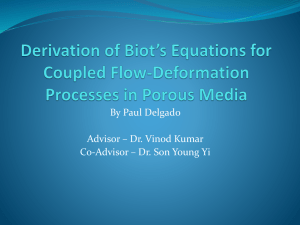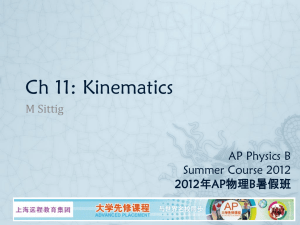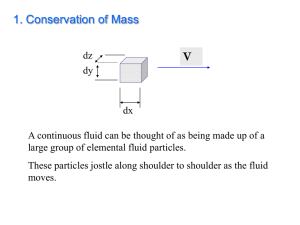Document
advertisement
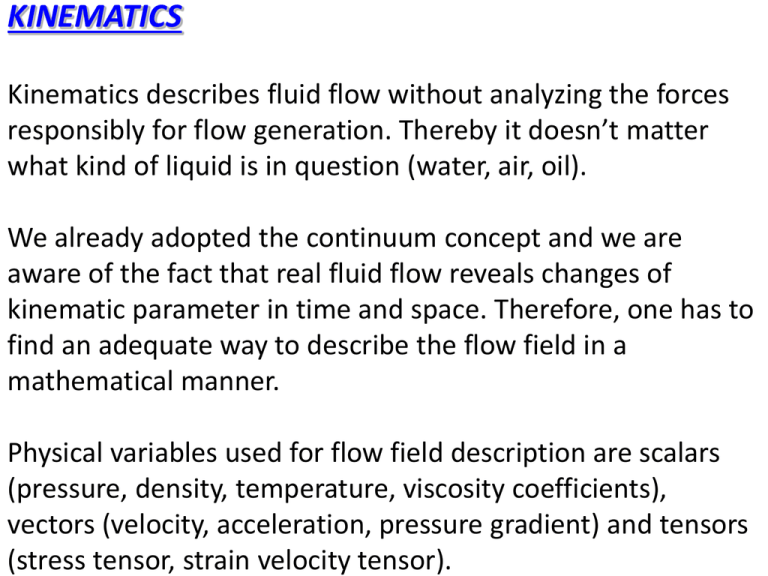
KINEMATICS Kinematics describes fluid flow without analyzing the forces responsibly for flow generation. Thereby it doesn’t matter what kind of liquid is in question (water, air, oil). We already adopted the continuum concept and we are aware of the fact that real fluid flow reveals changes of kinematic parameter in time and space. Therefore, one has to find an adequate way to describe the flow field in a mathematical manner. Physical variables used for flow field description are scalars (pressure, density, temperature, viscosity coefficients), vectors (velocity, acceleration, pressure gradient) and tensors (stress tensor, strain velocity tensor). KINEMATICS Gradient of scalar field is vector: x g ra d y z In Cartesian coordinate system the vectors of position x, velocity v and acceleration a are expressed with three components: x x t u u t x y v yt v a v t z z t w w t The example of total differential for pressure field gives: p p p p d p d x d y d z d t x y z t and for steady process: t 0 KINEMATICS Two different approaches exist when considering the flow of fluid: according to Lagrange and according to Euler. In the Lagrangean approach an observer moves together with the separate fluid particle and “feels” total changes of kinematic parameters during the time elapsed. In Eulerian approach the whole flow field is observed and described from one fixed spatial coordinate. In order to define the connection between Lagrange and Euler description of fluid flow we introduce terms as: total change, convective change and local change. KINEMATICS Imagine a situation where we are moving through a temperature field that exhibits spatial and temporal changes T(x,y,z,t). After some time elapsed we would experience the total (substantial) temperature change in time DT/Dt (dT/dt). We can separate that total change DT/Dt into the partial change in time T/t (at fixed coordinate in space) and partial change in space T/s (for one moment in time – fixed coordinate in time). D T T T T T u v w D t t x y z l o k a l n a k o n v e k t i v n a k o m p o n e n t a KINEMATICS During the movement from space coordinate 1 to 2 an observer will feel total temperature change dT due to partial change along spatial coordinate T/s·ds along the temporal coordinate T/t·dt The same approach can be also applied at any vector field. a D u D t x D u u u u D a a D v D t u u u g r a d u y D t D t t t a D w D t z KINEMATICS In fluid mechanics we are dealing with relationships between stresses and strain velocities and not between stresses and strains as was the case in the study of solid body mechanics. Strain velocities define the rates of fluid particle rotation and deformation (includes dilatation and angle deformation). In case of steady and non-uniform pressurized pipe flow the fluid particle will accelerate as the consequence of decrease in pipe diameter. Accordingly, particles of an incompressible fluid will elongate in flow direction and shrink in perpendicular direction. KINEMATICS Three different changes of fluid particle take place: a) translation, b) rotation, c) deformation (dilatation, angle deformation) Translation is easy to describe with the aim of velocity vector placed in the center of gravity for the observed fluid particle (analog as in case of solid body translation). The part including rotation and deformation is described with velocity gradient tensor. The rate of rotation is equal to angular velocity (change of angle in time di/dt). KINEMATICS KINEMATICS After time increment t fluid particle rotates by average value of angle X and Y : Δ y v 1 v αx Δ xΔ t Δ t Δ x x Δ x x Δ y Δ x u 1 u αy Δ yΔ t Δ t Δ y y Δ y y Δ x The net rate of rotation about z axis can be expressed as algebraic mean of both rates of angle deformation. It is denoted as angular velocity Z. (analog 1 w v for remaining two directions X ,Y) ωx α α 1 d v u x y ω z d t x y 22 2 y z 1 u w ωy 2 z x KINEMATICS The rate of deformation consists of two components: volume dilatation (exist only in compressible fluids) and angle deformation. When dealing with angle deformation one use the same procedure as in case of rotation, with the special attention given on the sign of angle. The rate of angle deformation in x-y plane is given by equation: 1 u v e 1 2 2 y x vj 1 T 1 vi e v v ij 2 2 x x j i KINEMATICS It can be shown that rotation and deformation represent the components of velocity gradient tensor. u x v grad v v x w x u y v y w y u z v z w z The rate of deformation is described by symmetric part of tensor, where the diagonal members represent volume dilatation, and off-diagonal members angle deformation. The sum of diagonal members defines total volume dilatation (divergence), that is equal to 0 in case of incompressible fluid. KINEMATICS The members of tensor symmetric part in 2D problems are: (dilatation and angle deformation) u 1 u v x 2 y x T 1 v v 1 2 v u v 2 x y y Antisymmetric part of the tensor covers the rotation and consists of angular velocity vector components (for 2D case): 1 u v 0 2 y x 0 ω T 1 z v v ω 0 2 1 v u z 0 2 x y For 3D case: 0 ωz ω y ωz 0 ωx ωy ωx 0 KINEMATICS The rate of volume change for fluid particle is described by divergence. If fluid particle elongation occurs only in xdirection, there is positive change in volume: u Δ V o l Δ xΔ t Δ yz Δ x The same is valid for the other two directions y and z. In 3D case the rate of volume change is given by velocity vector divergence: V o l 1 u u w d i v v tΔ x Δ y Δ z x y z For the incompressible fluid holds: d ivv 0 KINEMATICS Pathline – the trace showing the position at successive intervals of time of a particle which started from a given point (Lagrange approach). Streakline – gives an instantaneous picture of the positions of all the particles which have passed through the particular point at which the dye is being injected. Streamline – an imaginary curve in the fluid across which, at a given instant, there is no flow. Thus, the velocity of every particle of fluid along the streamline is tangential to it at that moment. In case of steady flow all three curves are the same. Stream tube consists of streamlines. There is no flow through boundary streamlines. KINEMATICS KINEMATICS The total quantity of fluid-flowing volume in unit time past any particular cross-section of a stream is called volume discharge Q. Mass discharge QM is obtained through the multiplication with density . 3 Q v c o s d A m / s A 3 QQ k g / m m Applying the law of mass conservation on incompressible fluid flow through the conservative pipe one gets the continuity equation, written in simple form as: Q Q v A v A 12 1 12 2 THE CONSERVATION LAWS – transport equation The changes in physical fields (velocity, concentration) are carried out by transport process. Mathematical interpretation of transport process is given through transport equations, also representing the conservation law of arbitrary physical field. We distinguish the intensive fields (independent of mass amount – scalar field of pressure or temperature ; vector field of velocity or acceleration) and the extensive fields (dependent on mass amount – scalar fields of mass, energy, entropy ; vector field of force or momentum) . THE CONSERVATION LAWS – transport equation In analyzing the transport process it is convenient to rely on volume and not on mass, so one has to introduce the term density of transport property = dJ/dV (transport property / volume; e.g.. transport property is mass mCO2 in volume V accompanying density is concentration with the unit kg/m3). Integrating over closed volume (indicating m = const.) that could be time-dependent (V(t) – the so-called material volume) one reads: Jt ( )d V Vt () THE CONSERVATION LAWS – transport equation Temporal and spatial distribution of fluid properties in flow field (concentration, temperature, pressure, velocity ...) are defined by the law of property conservation (mass, energy, momentum) in the form of its total change in time dJ/dt. For one moment in time t the material volume is given by V(t). After the time increment t initial volume V goes to: V(t+t) = V(t) + V(t+t) = V+V. and the density of transport property (t) goes to (t+t). As the time increment approaches zero (t 0) the volume change also approaches zero V 0. THE CONSERVATION LAWS – transport equation d J Jt ( t)Jt () lim t 0 d t t 1 lim (tt)d V(tt)d V () td V t 0 t V V V 1 lim (tt)() t d V(tt)d V t 0 t V V THE CONSERVATION LAWS – transport equation Total or substantial change of transport property J(t) in time is defined with the equation: d J d d V d V ( v d A ) d td t t V ( t ) V ( t ) A ( t ) V(t), A(t) are dependent only on time instant t (not on t+t). It is possible to replace the material volume V(t) with time independent volume V(t) = V = konst. that is fixed in space. Belonging material surface area A(t) is also to be replaced with stationary surface area A(t) = A = const. Accordingly, the term “material volume” V(t) is to be replaced with the term “control volume” (V) and the term “material surface” A(t) with the term ”control surface” (A). THE CONSERVATION LAWS – transport equation Finally, transport equation reads: d J d V ( v d A ) d t ( t V ) ( A ) If velocity vector v has the same orientation as outer normal n on any segment of control surface (A), their multiplication gives the positive value. When dealing with terms of control volume and control surface one relies on Euler approach. The absolute-total change in time dJ/dt is divided in two parts: the first is partial change in time for fixed spatial coordinate (local change) and the second is partial spatial change at fixed moment in time (concoctive change). THE CONSERVATION LAWS – transport equation If local component equals 0, the flow is steady. If convective component equals 0, the flow is uniform. Applying the GGO theorem: a d A d i v a d V A V on transport equation: d J d V ( v d A ) d t ( t V ) ( A ) reads: d J d i v ( vd ) V d t (V t )


